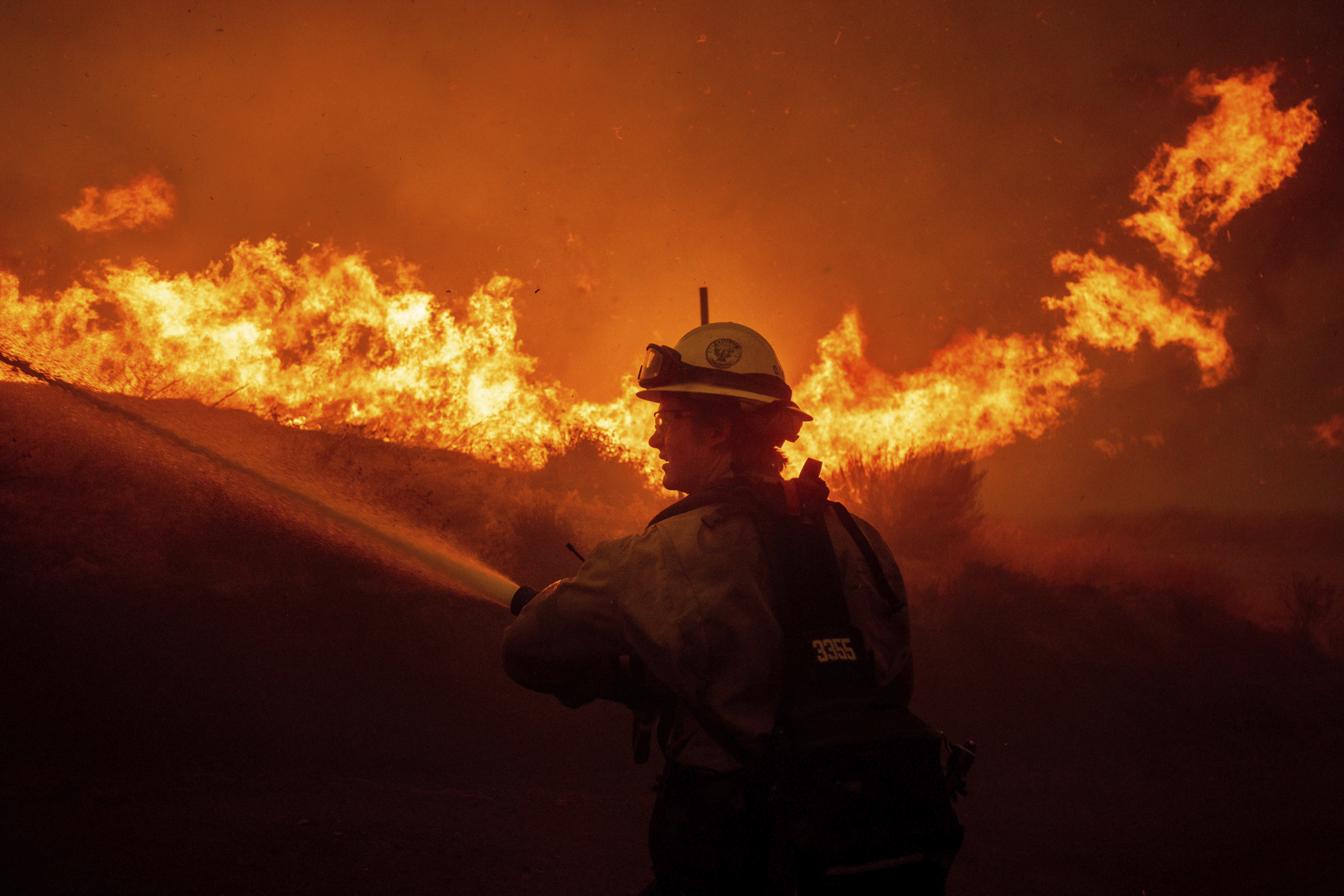Funding To Fight Fires — Not Crime — Is New Priority For Many California Cities

For years, California’s police commissioners have used the image of stolen cars and shattered windows to demand more crime-fighting resources. Now, fire chiefs are hoping to use the sight of understaffed, underfunded crews struggling to avert catastrophe in Los Angeles as they ask city and county governments to prioritize their departments.
Many municipalities are already considering approaching voters with a wide range of new taxes and borrowing measures they hope will fend off the increasingly existential wildfires that have swept the state over recent years.
"Fire is one of the biggest issues in a bunch of communities,” said Robb Korinke, a Southern California-based political consultant who specializes in local-government ballot measures. “There's going to be a record number of cities seeking revenue."
Over the last decade, fear of fire risk has moved from wooded rural Northern California and the dry foothills of the Sierra Nevada to the state’s south and coastal regions, and to urban areas throughout. According to recently released polling from the Public Policy Institute of California, a nonpartisan research firm, almost 80 percent of Californians now consider wildfire a problem.
Now both big-city Oakland and the tiny Central Valley hamlet of Dos Palos have called special elections in an attempt to convince voters of new taxes to prevent the closure of fire stations. Los Angeles officials have directed city staff to prepare a 2026 bond (just months after voters approved a fire prevention tax) to finance the renovation and construction of firehouses and improve response times. As Democratic San Jose Mayor Matt Mahan fields questions from residents if their homes could be next, the mayor is asking the City Council to find ways to safeguard the region.
“This is an issue that has united Oaklanders more than anything else I've seen,” said Oakland city councilmember Janani Ramachandran, a Democrat. “This needs to be our main priority right now.”
The California Fire Chiefs Association, a statewide advocacy group, is meeting next week in Pasadena to discuss how to wring more money out of city and county governments.
Fire chiefs will find themselves on a collision course with other needs that gained preeminence as cities confronted a pandemic-era crisis in public safety. Unlike in Sacramento and Washington, where lawmakers can haggle over budgets in private, local efforts will have to take place out in the open to persuade voters to approve new taxes and bonds.
“As a city, we’ve been holding the bag for really complicated issues like housing, addiction, social services,” said Traci Park, a Los Angeles city councilmember and Democrat who represents the Pacific Palisades neighborhood where over 5,000 homes were destroyed. "They are all great things to have, they are services we’d like to be able to provide. But they are way outside basic municipal services.”
'We are not prepared for disaster'
There was no single day that California’s fire stations fell underwater. Instead, it was a drip-drip of problems pooling over decades, a faucet rather than a fire hose.
Proposition 13, the 1978 statewide initiative that capped property taxes and limited annual adjustments, dramatically reduced revenue for local governments, contributing to a cash crunch around city services. Economic downturns after the dot-com boom and the Great Recession led to structural budget deficits in both small towns and urban areas. As the state grew, more homes were built in fire-prone areas, but the money to fund fire prevention and response didn’t grow with it. Rapidly escalating costs of equipment and a staffing shortage made problems worse.
In Oakland, as in so many cities and counties around the state, that means fewer firefighters in aging buildings fielding more calls than ever.
The city has dealt with a budget deficit since the 1980s and, in recent years, has tried to plug funding holes with one-time boosts like Covid-19 relief money and an anticipated stadium sale. When that transaction was delayed last year, the City Council turned to a contingency budget to address its deficit. It included shuttering two of the city’s 25 fire stations, with more closures potentially to come.
Oakland, where a 1991 firestorm killed 25 people and destroyed nearly 3,000 homes, is not a good place to be unprepared for fire. Of the high hazard wildfire zones mapped by the state, the bayside city’s wooded hills sit at a perilous statistical overlap — the most densely populated with the fewest evacuation routes.
Now, even as fire units respond to medical calls and battle frequent blazes at homeless encampments across the city, Oakland is trying to find ways to avert further closures. That could mean painful cuts into other programs, or new taxes on residents already complaining about high costs.
“We understand where we are fiscally as a city,” said Oakland Fire Chief Damon Covington at a town hall organized last week to address residents’ concerns about fire station closures. “But we feel like there should be other options to balancing the budget.”
The possibility of closing fire stations to solve budget issues was painful six months ago. After the Los Angeles fires, it’s become politically untenable — “an object lesson of what we do not want to happen here,” as Zac Unger, a former firefighter elected last fall to Oakland City Council, put it. Unger warned that further closures would be “the end of the Oakland Fire Department as we know it.”
In Los Angeles, Park, the city councilmember, has excoriated the poor condition of the city’s approximately 100 fire stations, many of them over 50 years old. “I hate to use the Palisades fire as an I told you so moment, but I literally went to the fire commission 21 days before the fire and said we are not prepared for a disaster,” she said.
Los Angeles city councilmember Monica Rodriguez, a Democrat who represents a section of the San Fernando Valley that has been affected by previous fires, said she’s been battling to bring a new fire department to her district for decades. The Los Angeles Fire Department is among the most understaffed in the country, and has the same number of fire stations and firefighters as it did 60 years ago, according to Park. San Diego has even fewer firefighters per-capita.
“We know through our standards of cover what we need to do,” said Rodriguez of the city’s policies for distribution and response time of emergency services. “But the problem is we don’t have the resources to do it.”
The firefighting next time
Politicians believe the time is right to ask voters to give them more money to fight fire. Nearly all of the three dozen local measures designed to do so via the 2024 ballot, from a sales tax in Yreka to the South Lake Fire Protection District increasing its spending limits, passed.
In Dos Palos, a rural Central Valley community of 6,000, voters will next month be presented with a half-cent sales tax to keep a fire station running within city limits after Merced County slashed its emergency-services budget. In nearby Livingston, voters last fall overwhelmingly supported a 1 percent transaction and use tax to fund its first city-run firehouse.
The half-cent increase on Oakland’s ballot in April would give the city a sales tax equal to the state’s highest. Although the estimated $20 million in new annual revenue would land in the general fund, fire services are among the priorities for the money, according to members of the City Council.
In Los Angeles, where voters last year approved a bond issue to shrink thoroughfares and a new sales tax to fund anti-homeless projects, officials exploring a 2026 bond issue for fire want to capitalize on the current moment to make the dollar amount they ask of voters as high as possible.
“If they’re willing to spend $3.5 billion on road diets,” Park said, “I think they'd be willing to pay for some fire stations.”
Still, jurisdictions must survey the political will of a community as they choose between extracting new revenue via taxes or hitting bond markets to borrow. Should a city prioritize the ongoing costs of running a fire department, like Oakland? Or one-time investments in trucks and firehouses, like Los Angeles’ bond?
Some outside support for cities and counties might finally be coming. Earlier this month, Gov. Gavin Newsom proposed $2.5 billion in additional support to aid recovery efforts in Los Angeles and fund further wildfire preparedness. Last week, California representatives Josh Harder and Doug LaMalfa introduced a bill in Congress that would compensate local fire departments for fighting fires on federal lands.
Regardless, local governments may end up in the same position they have been in for years. Potholes, tree clearing, police and firefighters are but one piece of a funding puzzle which has increasingly grown to include housing and social services. In the aftermath of the Los Angeles fires, the whack-a-mole approach to city finances may now correct toward fire, while other spending and borrowing priorities are set aside.
“These are terrible times and we're going to have to make terrible choices,” Unger, the Oakland firefighter-turned-councilmember said. “If there was a Department of Doing Nothing in the city, we would all know that was the place to cut. Instead, there are only good programs started by good people.”


